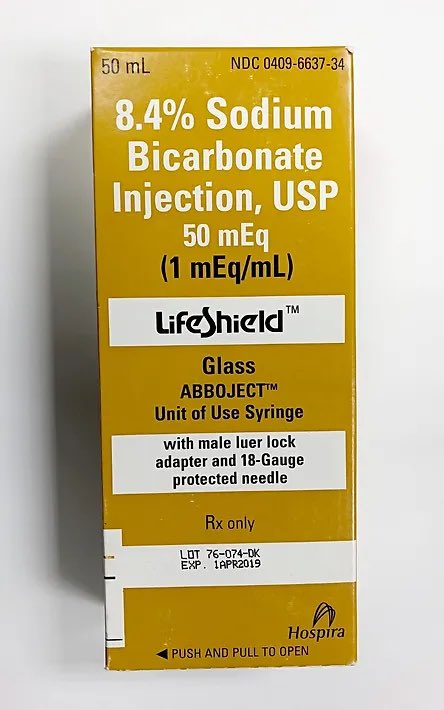You've Probably Heard Th...

Highlights
- You've probably heard that Bicarbonate has to turn into CO2 to raise the pH. “Don’t give bicarb if you can’t increase ventilation.”
But how much CO2 is there in an amp of sodium bicarbonate?
A bicarb 🧵
1/
 (View Tweet)
(View Tweet)
- Sodium bicarbonate raises the pH by binding H+ ions and turning into CO2 and water.
For my fellow 🧪 nerds, I’ll write:
HCO3 (aq) + H+ (aq) --> CO2 (g) + H2O (l)
2/
 (View Tweet)
(View Tweet)
- This means that - just like adding alka-seltzer to water - when we give sodium bicarbonate we liberate CO2 & raise the pH!
In fact the major ingredient in Alka-Selzer is sodium bicarb!
(Also can we agree that this is the creepiest mascot ever?)
https://t.co/9G78a9PRzC
3/ https://t.co/Vvvu854KAt (View Tweet)
- But how much CO2 do we get from an amp of bicarb?
50 mEq = 0.05 mol of NaHCO3
So assuming the reaction runs to completion* we get 0.05 mol of CO2.
But how much is that?
(*more on this assumption later)
4/
 (View Tweet)
(View Tweet)
- 1 mol of CO2 occupies 22.4 L at STP. Using the ideal gas law we calculate it’s 23.3 L at 37 C.
That means an amp of bicarb has
0.05 mol * 23.3 L/mol = 1.16 L of CO2!
1.16 liters of CO2!?
That’s more than I expected & kinda a LOT. At rest a person exhales 200 ml of CO2/min!
5/ (View Tweet)
- That’s so much that we can actually see the increase in end tidal CO2 after pushing an amp of bicarb.
Here’s an experiment done on anesthetized dogs: ETCO2 increased by about 25%.
https://t.co/9NKZVzAtfF
6/
 (View Tweet)
(View Tweet)
- If humans are similar to dogs (a 25% increase in CO2 excretion) we’d go from 200 ml/min to 250 ml/min. Thus:
1.16 L / 50 ml/min = 23 min
That means it will take 23 minutes to get rid of the extra CO2 produced from one amp of bicarb!
7/ (View Tweet)
- Worth pointing out that the CO2 from a bicarbonate drip is trivial:
A bicarb drip is 3 amps of bicarb in 1 L of D5W, usually 100-150 ml/Hr.
150 mEq/L * 125 ml/Hr = 18 mEq/hr
- One more point about bicarb.
You might have seen someone’s SpO2 come up after pushing an amp. That’s true…but it’s not necessarily a good thing!
I’ll explain: Recall our old friend the oxyhemoglobin dissociation curve:
9/
 (View Tweet)
(View Tweet)
- Imagine someone w/ severe acidosis (pH=6.8) & moderate hypoxia (PaO2=60); their SpO2 is terrible (65%).
If we give an amp of bicarb the same PaO2 will now have a better SpO2 (90%)
…but all we’ve done is push O2 back onto hemoglobin! We didn’t actually improve O2 delivery!
10/
 (View Tweet)
(View Tweet)
- Remember even though bicarb can temporarily make things look better, it doesn’t fix the problem!
As a friend said “bicarb is the Spanx of the ICU”
11/

 (View Tweet)
(View Tweet)
- The 🔑 point of this 🧵 isn’t “don’t use bicarb” it’s remember that one amp of bicarb goes a long way!
Giving repeated frequent bicarb pushes, particularly in someone with maximal minute ventilation, probably won’t help very much.
12/ (View Tweet)
- If you enjoyed this lmk. Happy to do future threads on this; we can talk all about lactic acidosis & bicarb, ion trapping, strong ion difference, & bicarb as an antidote. Get excited my fellow physiology nerds!
13/ (View Tweet)
- Bonus tweet: this makes a great science experiment with kids or ICU fellows.
Combine alka seltzer with vinegar and watch the CO2 fill up balloons. 🎈Measure the pH with litmus paper.
If you do this in a sealed container with no room for the gas, the pH won’t change (as much)!

 (View Tweet)
(View Tweet)

 (View Tweet)
(View Tweet) (View Tweet)
(View Tweet) (View Tweet)
(View Tweet) (View Tweet)
(View Tweet) (View Tweet)
(View Tweet) (View Tweet)
(View Tweet)
 (View Tweet)
(View Tweet)
 (View Tweet)
(View Tweet)